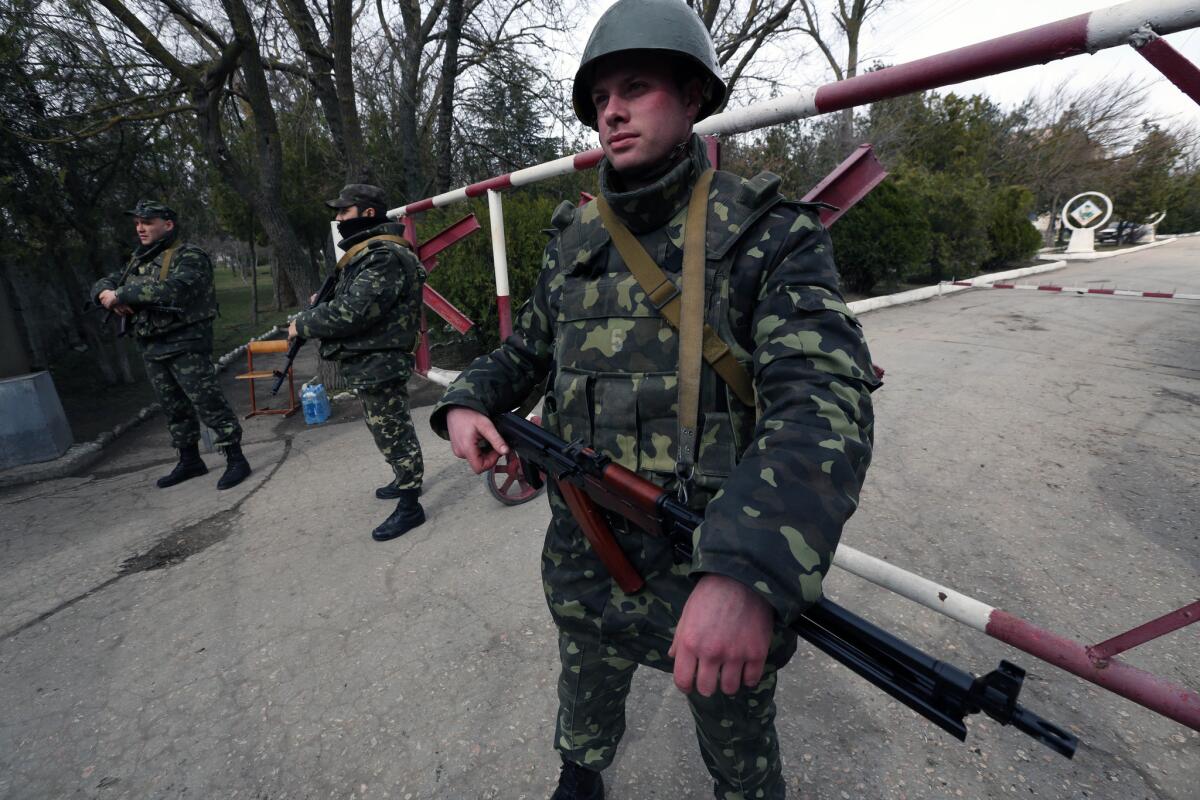Russians lift portions of blockade in Crimea, Ukrainian officers say

- Share via
YEVPATORIA, Ukraine -- Russian troops have at least temporarily lifted their blockade of several Ukrainian military installations in Crimea, commanders said Thursday.
“Wednesday late at night the Russian paratroopers which deployed all over our base suddenly packed and went away,” said Lt. Col. Olexandr Lomako, deputy commander of Ukraine’s anti-aircraft regiment stationed in Yevpatoria, a resort city about 60 miles northeast of Sevastopol. “But when leaving, their commander said that they will be back.”
The Yevpatoria unit was one of many surrounded or invaded by unidentified gunmen last weekend as heavily armed troops in Russian military fatigues and Russian-registered vehicles moved onto the peninsula to take control of the airport, bases and other key installations. In Yevpatoria, the gunmen seized the regiment’s command station and missile installations, according to Ukrainian authorities.
As soon as the “the green men” or “grasshoppers”, as Ukrainian officers referred to the invading force, departed, left, officers of the unit opened locked firearms storage units and armed their men.
“The Russians captured our base and disarmed us only because they took us by surprise and because we didn’t want to start a big war by armed resistance,” Lomako said in an interview with The Times.
He added that because Russian President Vladimir Putin has described the gunmen as local self-defense forces rather than acknowledging they are part of the Russian military, “We decided to consider them an illegal armed gang and should they reappear again and attack us we will use every means at our disposal including firearms to defend our base.”
Before “the green men” left, however, they cut off communication lines between the unit and its command station, Lomako said.
By Thursday morning, the Russians also lifted their blockade of at least two other Ukrainian defense bases, the military unit in the city of Bakhchisarai and the naval base in the town of Novoozernoye.
The blockade, however, continued in some other parts of Crimea including Sevastopol, where Russian troops continued to surround Ukraine’s naval headquarters.
Crimea’s Russian-controlled parliament on Thursday set a March 16 date for a referendum on whether the Crimean region should secede from Ukraine and join Russia.
“The illegitimate moves of the Crimean parliament working under the control of the Russian troops indicate that they are really desperate to hold the so-called referendum as soon as possible while the Russian occupying force is still here,” Lt. Col. Alexei Mazepa, a regional spokesman for Ukraine’s Defense Ministry said in an interview with The Times. “Each new day of Russian military presence here makes it more and more difficult to explain to the world what his country’s armed soldiers are doing in a sovereign foreign country.”
The Russian troops’ latest moves may indicate they are either preparing to leave or “simply need a day off to go to a banya [to take a bath], eat some hot food for a change and regroup themselves,” said Mazepa.
Russian troops, meanwhile, sank one of their old anti-submarine vessels in a Black Sea bay. The action, Ukrainian officials said, locks in Ukrainian naval vessels stationed at a base in Novoozernoye.
“Frankly we could expect anything from our friendly Russian navy nowadays but what they have done today is an outright sign of a military aggression,” said Capt. Oleg Sokolov, deputy commander of the Ukrainian naval base in Novoozernoye, 120 miles northwest of Sevastopol. “The sinking of their vessel … makes it impossible for our navy and civilian vessels to get out to sea.”
The rusty vessel, more than 400 feet long, was towed to the mouth of the bay under cover of darkness Wednesday night, Sokolov said.
“They had to set off an explosive device in the bottom of the ship to make it sink in a matter of half an hour,” said Sokolov.
sergei.loiko@latimes.com
More to Read
Sign up for Essential California
The most important California stories and recommendations in your inbox every morning.
You may occasionally receive promotional content from the Los Angeles Times.










